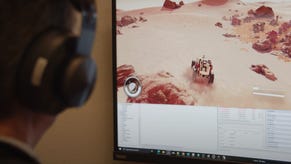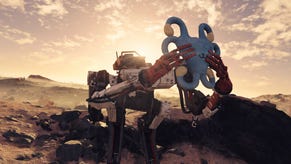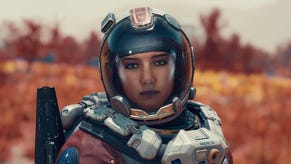Starfield's biggest problem is that you can't play Skyrim for the first time again
Mountains of the mind.
In Sunday's Starfield Direct, Bethesda took pains to join the dots between its established role-playing franchises and this year's mammoth space epic. For all the vaster playspace, with a thousand planets to roam and marvel at or at least, blow up for materials, Starfield will remain a Bethesda RPG "through and through" - pitched squarely at those, like myself, who shovelled hundreds of mortal hours into the furnaces of Skyrim and Fallout 3.
The footage showed off a lot of familiar ideas - level up points! Crafting! Romanceable NPCs! - carefully positioned to spark reassuring nostalgia amid ostensibly exotic surroundings. There was a huge emphasis on the same-but-more, with certain lines from studio director Todd Howard building on Bethesda presentations from over 10 years ago. See that moon? You can go there. Oh, and here's an Abandoned Mine, not actually abandoned, to waylay you en-route to the next story objective with the promise of a neat gun. And here's a lounging skeleton who wants a quick word in your ear about Ye Olde Environmental Storytelling.
As my snarky intro hopefully illustrates, presenting Starfield as a game for returning players overlooks that many of Bethesda's oldest disciples are also its biggest haters. Overfamiliarity with the developer's teeming, rough-edged open world RPG design breeds a strange mixture of intense admiration and contempt, which I don't think you see in responses to rival franchises like Souls or Assassin's Creed.
The contempt springs partly from the fact that Bethesda keeps describing these games in messianic terms - in the Direct, Todd Howard often sounds like he's seconds away from birthing a sentient AI - whereas in practice, they're characterised by bugs and a pervasive, charming unsteadiness resulting from the sheer number of interlocking systems in play. Starfield's trailers make it look extremely slick and cohesive, all slow pans across starkly shadowed planetscapes, sliced through by the rings of nearby gas giants, but I don't doubt it will have its equivalent of Skyrim's backwards-flying dragons, or Fallout 4 players getting sucker-punched during quest-critical dialogue by wandering robots.
Hiccups like these have arguably worked well for Bethesda in the past. YouTube and social media are full of clips of things going wildly awry in Skyrim, and as the saying goes, there's no such thing as bad publicity. It's the same magical absurdity Minecraft once conjured with its gravity-defying floods and accidental forest fires. I think the technical inconsistencies will be harder to defend in Starfield, though, mainly because this is the first new Bethesda Game Studios IP in generations and the tentpole Xbox exclusive at the time of writing, but also because a game full of portrayals of relatively functional, albeit handworn technology creates expectations for itself that fantasy RPGs like Elder Scrolls don't have to worry about. Ship-building especially has nightmarish possibilities. Imagine if Bethesda itself were one of Starfield's in-game component manufacturers? You wouldn't dare set foot in a cockpit.
A bigger problem though is that Starfield's own premise of an interplanetary expedition has a diminishing effect on what the game brings back from Skyrim and Fallout, especially given that it doesn't appear to support real-time, in-game transitions between its two halves, as in the obvious competitor, No Man's Sky. Not being able to manually pilot from those glittering cosmic wastes through the atmosphere to a planet's surface makes Starfield's rhythms of questing, sidequesting, exploration and upgrading seem all the homelier, like vacuum-sealed chunks of last-gen role-playing. These are brave new horizons, Jim, but don't worry, here's a local scientist who needs you to exterminate some loudly-coloured indigenous lifeforms, and here's some ore you can blast apart for crafting ingredients.
.jpg?width=690&quality=75&format=jpg&auto=webp)
I'm being snarky again, but I don't feel snarky. I think a portion of the derision directed at Starfield, with its huge scope that seems to only promise more of the same, stems simply from missing how these gameworlds used to make us feel. Oblivion and Skyrim were a success because they built a following outside the existing Elder Scrolls niche. They achieved this primarily by simplifying the role-playing systems and worldbuilding they inherited from funky uncle Morrowind, with both eyes firmly on the console market. But Skyrim also wove an enchantment through its geography and perspectives that stands apart from its more acquisitive and reductive elements, and which no descendant or imitator has ever quite managed to recapture. Indeed, the consolidation of the open world genre has only served to bury the glories of games like Skyrim, their landscapes subordinated to the habit-forming infrastructure and resourcing loops of the Game-as-Service.
I'm curious to know how Starfield appears to players who aren't recovering Bethesdaficionadoes, sagging under the weight of all that Abandoned-Mine-fatigue, because after all, I used to be one of them. I can still recall the moment I left a cavemouth in Skyrim, during a three-hour hands-on for Official Xbox Magazine, and first laid eyes on the realm.
Yes, we're all justly scornful of the phrase "see that mountain? You can go there". We are all justly suspicious of mega-corporate open worlders in general, the way that insatiable creed of see-it-go-there steals time and interest from equally adventurous, but more focussed artworks that have a millionth of the budget (your penalty for reading to the end of this feature, by the way, is that you're required to look up Jack King-Spooner's work and maybe play a bit of Elephantasy). But remember how it felt, when you first saw the clouds knit and swirl around the Throat of the World and the sunrise touch the slopes of Helgen. There's a dream there about what an "open" world could be, about the gentle wonder and curiosity it can inspire when you quit killing and looting, which the past decade has been slowly iterating us away from, and which Starfield is, perhaps despite itself, trying to rekindle.










